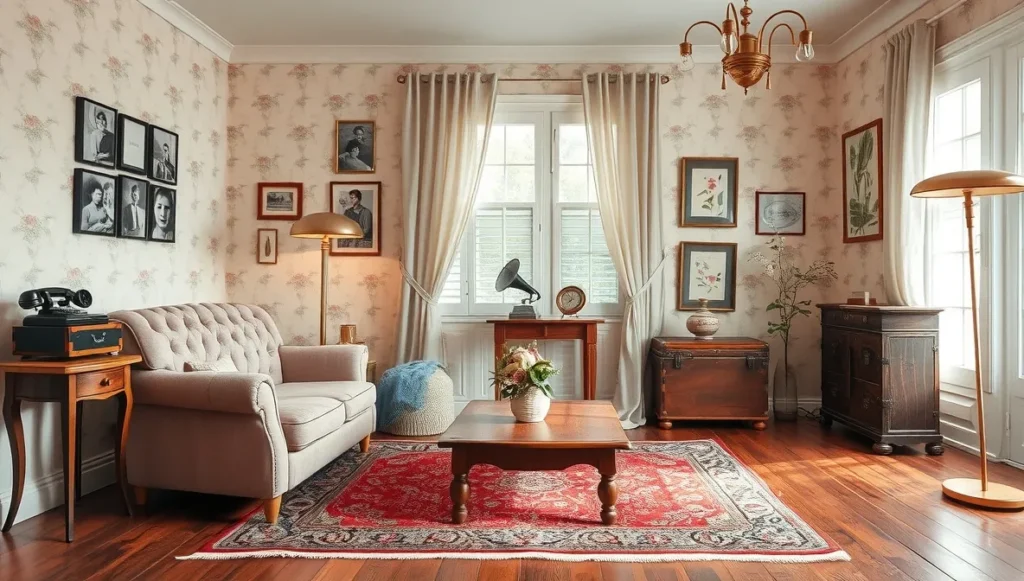- Why Vintage Interior Design Still Has My Heart - September 3, 2025
- Still in Love with Traditional Design – And Here’s Why - September 3, 2025
- The Enduring Charm of English Country Design: Why This Style Never Goes Out of Fashion - September 2, 2025
Table of Contents
So there I was in 2003, fresh out of design school, convinced I knew everything about “good design.” Clean lines! Minimalism! Everything white and chrome and perfectly sterile!
Then this lady calls me about her Boston brownstone.
Mrs. Henderson, sweet as pie, wants to “drag her house into the modern world.” She’s apologizing for all the “old junk” cluttering up her beautiful home. The carved mantelpiece? “So dated.” The built-in bookcases with original glass? “Need to go.” Those gorgeous hardwood floors with actual character? “Can we just cover them with laminate?”
I’m standing there with my clipboard, nodding like an idiot, when the light changes.
You know that moment in movies when everything suddenly makes sense? The afternoon sun hit those supposedly “outdated” built-ins, and I swear the wood grain started glowing. Every curve, every joint, every single detail was… perfect. Not factory-perfect. Human-perfect.
“Mrs. Henderson,” I said, “what if we don’t change anything?”
She looked at me like I’d lost my mind. Maybe I had.
What Even Is “Vintage” Anyway?
Right off the bat – vintage doesn’t mean “anything your parents owned.” We’re talking 20-100 years old, give or take. Your mom’s 1990s entertainment center? Still too new (and probably too ugly, sorry).
But here’s what really matters: vintage comes from an era when people built things to last forever. Before planned obsolescence became a business model. Before “some assembly required” meant you needed a PhD in engineering and three hours of your life you’ll never get back.
My friend bought this 1950s dining table at an estate sale for $300. Thing weighs about as much as a small car. Her kids have used it as a fort, a craft table, a homework station. Her husband somehow managed to spill paint thinner on it during their kitchen disaster of 2019. Still looks better than the $1,200 table she returned to West Elm because it started wobbling after six months.
That’s vintage for you.
Why Vintage Just… Works
Nothing Matches (And That’s Perfect)
Modern furniture stores want you to buy everything in sets. Bedroom set! Dining room set! Living room set! Like your house is some kind of hotel room.
Real homes don’t work that way. Never have.
My grandmother’s house had furniture from every decade between 1920 and 1980. Sounds chaotic, right? But walking in there felt like being wrapped in a warm hug. Every piece had a story – the chair her mother refinished during the Depression, the coffee table her husband made in his garage workshop, the lamp they bought on their honeymoon in 1952.
Nothing matched. Everything belonged.
Colors That Actually Make Sense
Instagram designers love those stark white walls with one dramatic black accent wall. Very striking. Also very impossible to live with if you’re, you know, human.
Vintage colors evolved naturally. Sage green that doesn’t clash with wood tones. Cream that makes tiny rooms feel spacious. Dusty blue that somehow works with both brass and chrome hardware. These aren’t “statement colors” – they’re livable ones.
I once had a client who wanted her kitchen painted bright orange because she saw it in a design magazine. We compromised on a soft butter yellow instead. Three years later, she’s still happy with it. Orange would have driven her insane by month two.
Making It Work Room by Room
Living Rooms (Start Here!)
Pick one piece you absolutely love. Could be a mid-century sofa you found on Facebook Marketplace, or your aunt’s weird but wonderful secretary desk. Build everything else around that anchor.
Don’t overthink the “period accuracy” thing. A 1940s coffee table can look amazing with a 1960s sectional if they share similar vibes. Wood tones help tie different eras together, but it’s more about feeling than following rules.
And please, for the love of all that’s holy, ditch the overhead lighting. Nothing kills vintage vibes faster than those horrible recessed lights builders put everywhere. Hunt for table lamps, floor lamps, anything that creates warm pools of light instead of that morgue-like overhead glare.
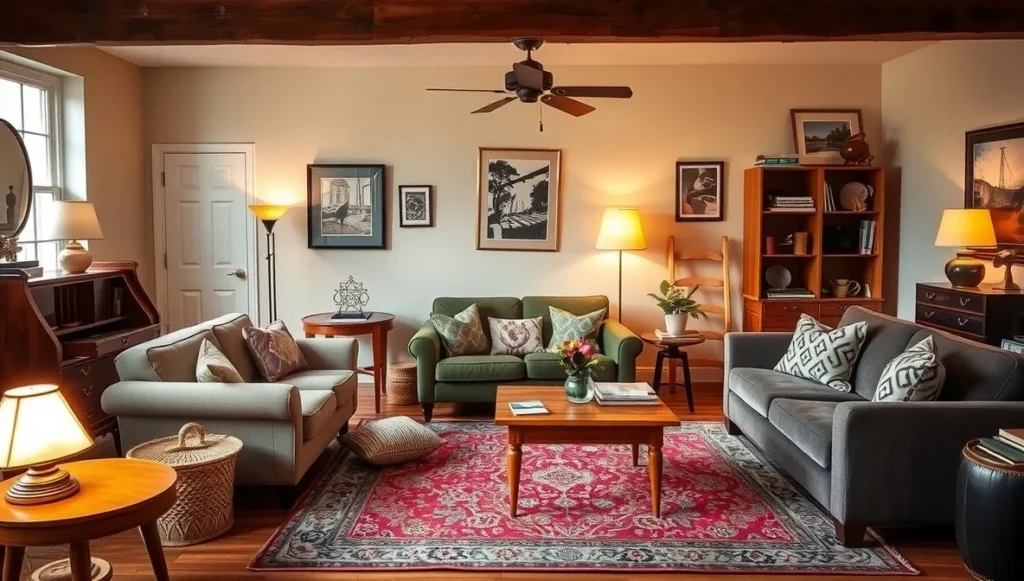
Dining Rooms (Go Big or Go Home)
Dining rooms are naturally formal, so you can really lean into the vintage thing here. Your table becomes the star of the show – maybe one of those expandable teak beauties from the 60s, or a solid mahogany beast from the 40s that’ll outlast civilization.
Here’s something weird I learned by accident: mix your dining chairs. Four matching ones plus two different ones at the head looks way more expensive and intentional than a perfect set. Found this out when a client inherited chairs from three different relatives and couldn’t bear to get rid of any.
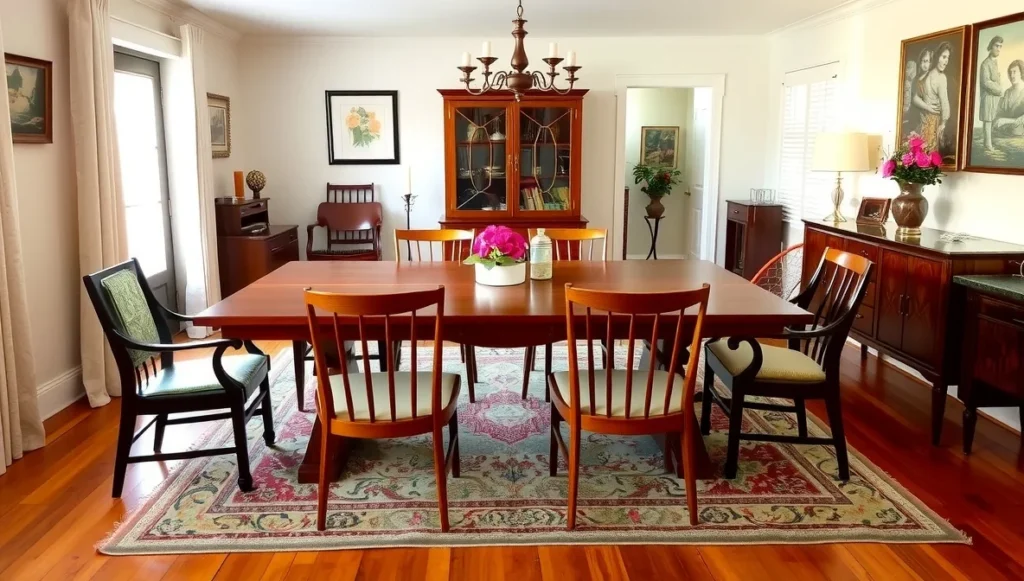
Kitchens (The Tricky One)
Okay, real talk – your refrigerator needs to keep food cold, your stove needs to cook things properly, your dishwasher needs to actually clean dishes. Don’t try to make 1950s appliances work in 2024 unless you enjoy repair bills and food poisoning.
But everything else? Fair game.
Glass-front cabinets show off vintage dishes (and force you to keep them organized). Subway tile never goes out of style because it was never really “in style” – it’s just good. Butcher block countertops get better with age instead of looking dated after five years.
Color transforms vintage kitchens. Soft yellow cabinets, mint green walls, classic black and white floors – these combinations have been making kitchens beautiful since before your great-grandmother was born.
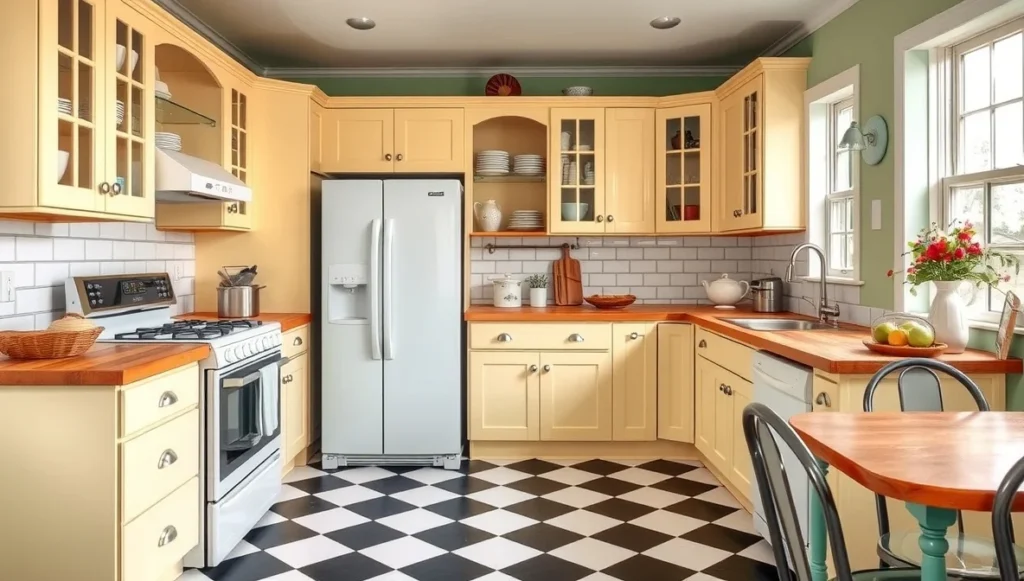
Bedrooms (Keep It Personal)
Start with the bed frame. Brass beds from the 1920s give you one vibe, sleek platform beds from the 60s give you another. Both are authentically vintage – pick what makes you happy.
Forget matching bedroom sets. They’re a modern invention anyway. Real vintage bedrooms collected furniture over decades. Dresser from the 50s, nightstands from the 30s, mirror from the 60s. As long as everything feels harmonious, exact matching is unnecessary.
Vintage textiles change everything. Real linen curtains that get softer with every wash. Wool blankets that last decades instead of pilling after three trips through the washing machine. Chenille bedspreads that feel like luxury instead of that synthetic nonsense they sell now.
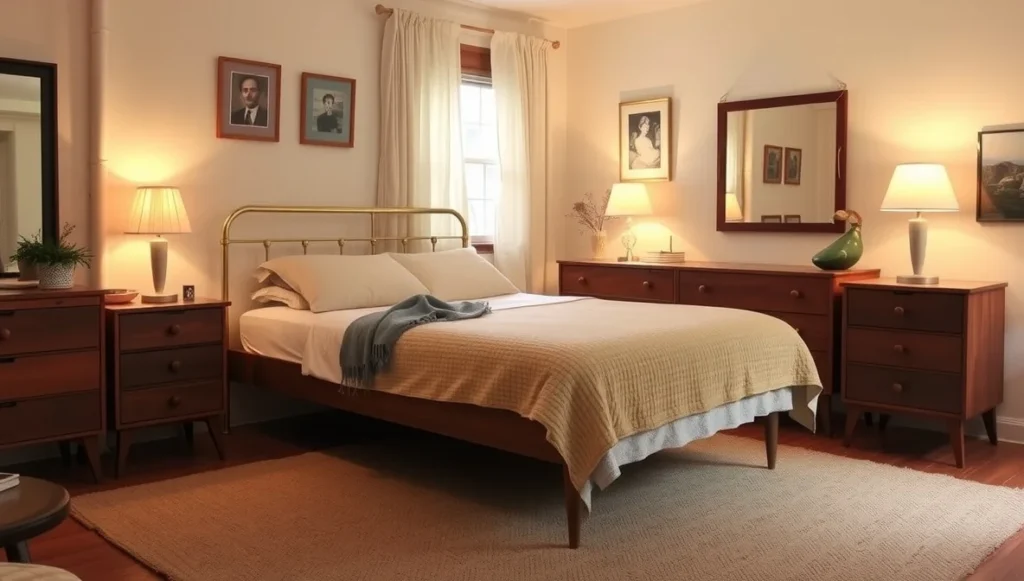
Bathrooms (Compromise Required)
You want modern plumbing that works reliably. Trust me on this. But surfaces and fixtures can capture vintage charm without vintage problems.
Pedestal sinks, subway tiles, hexagonal floors – all classic looks using modern materials. Medicine cabinets from the 30s and 40s often have better storage and more character than anything you can buy today. Just get them rewired by someone who actually knows what they’re doing.
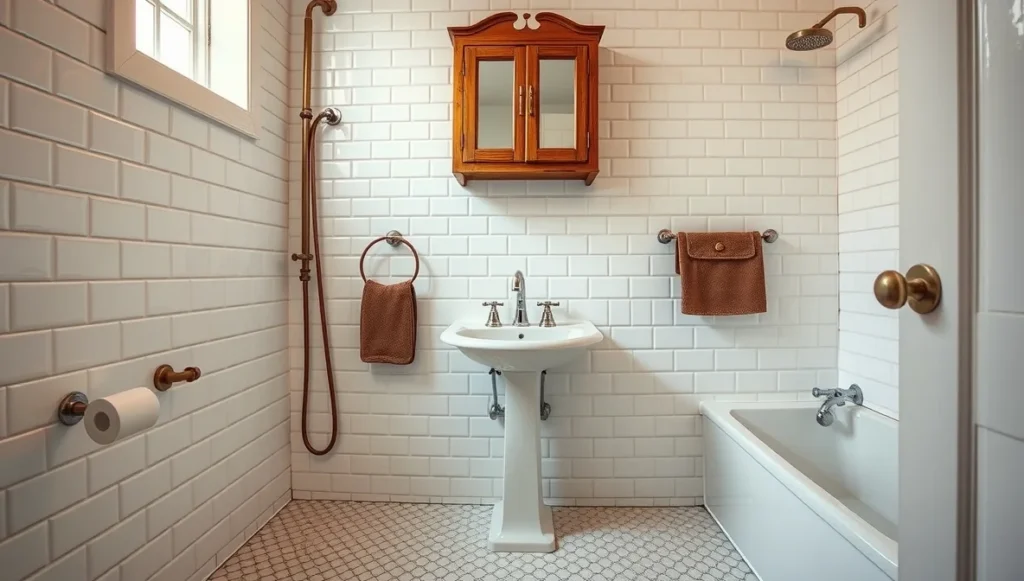
Home Offices (More Important Than Ever)
Remote work changed everything, right? Vintage home offices suddenly make perfect sense. Those mid-century desks have better proportions and way more personality than modern office furniture.
Plus, vintage office chairs are often surprisingly comfortable. And they look infinitely better than those ergonomic mesh things everyone’s buying that make your home office look like a corporate cube farm.
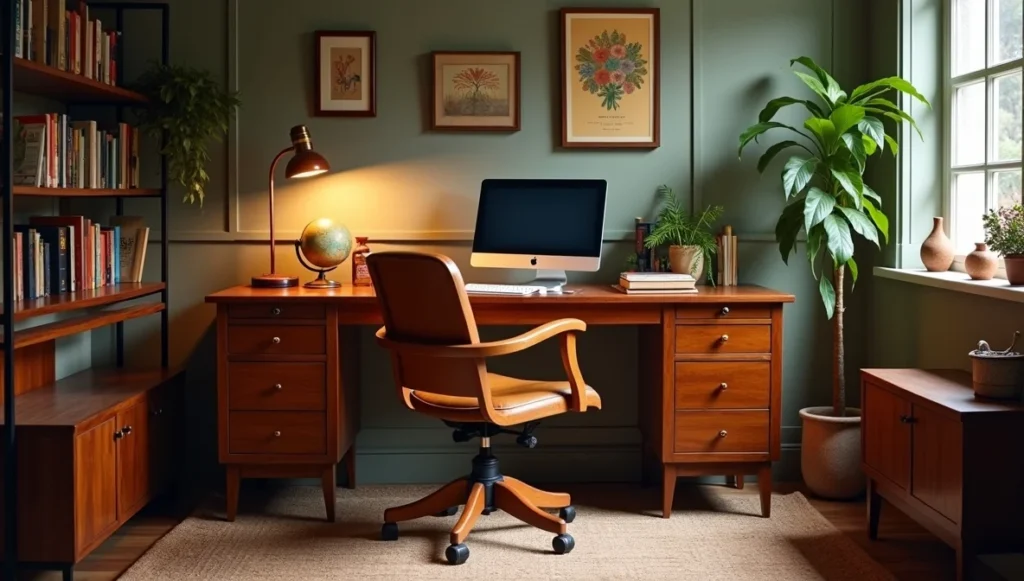
Entryways (First Impressions)
Small space, big impact. A vintage console table, mirror, and light fixture can establish your entire home’s personality before visitors see anything else.
Even tiny entryways can handle one meaningful piece. Vintage coat rack, umbrella stand, something that serves a real purpose while adding character.
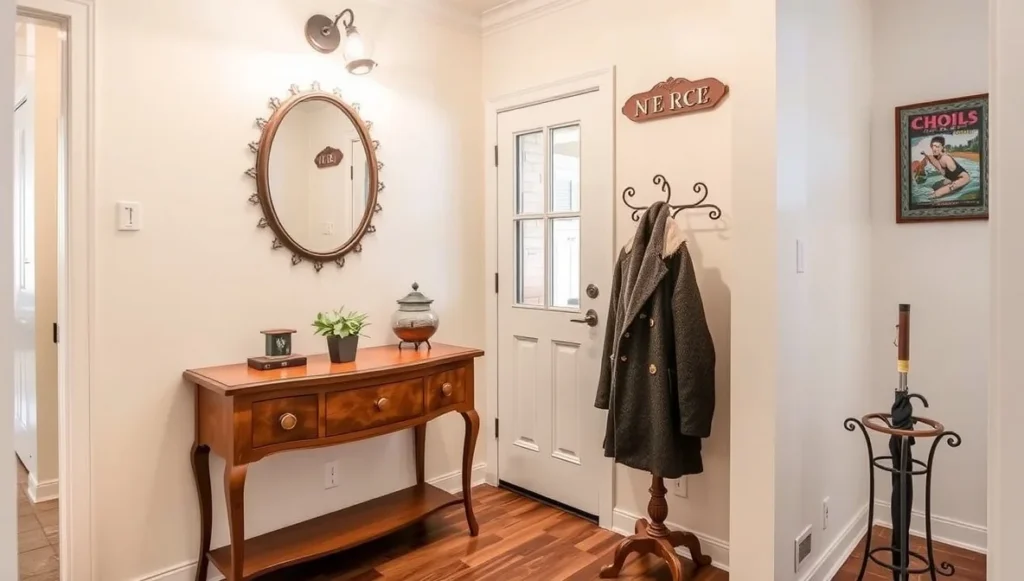
Common Mistakes (I’ve Made Them All)
Trying to Create a Time Capsule
Your home needs to work for your actual life, not win any period authenticity contests. Mix vintage pieces with modern conveniences. Use historically appropriate colors in modern paint that won’t chip or fade.
Nobody wants to live in a museum, no matter how well-curated.
Ignoring Scale and Proportions
Vintage furniture was built for smaller homes with lower ceilings. That delicate 1950s dining set might disappear in your great room. That massive 1970s sectional could overwhelm a cozy den.
Consider your actual space before falling in love with anything.
Buying Beautiful Things You Don’t Actually Need
That gorgeous bar cart is only worth it if you actually serve drinks to people. The stunning secretary desk only makes sense if someone needs workspace. Beautiful pieces that don’t serve your lifestyle become expensive dust collectors.
Ask yourself: “Will this make my daily life better?” If the answer’s no, keep looking.
Smart Shopping (Without Going Broke)
Estate Sales: Treasure Hunting at Its Best
First day for selection, last day for deals. Bring cash and a tape measure. Learn to spot quality – dovetail joints, solid wood, hardware that still works smoothly after decades.
Some of my best finds came from estate sales where the family just wanted everything gone.
Thrift Stores: Patience Required
You need to visit regularly. Good pieces move fast, but amazing pieces sometimes sit there because people don’t recognize quality. Build relationships with staff – they often hold interesting items for regular customers.
Focus on solid pieces that need cosmetic work rather than perfect pieces at collector prices. Ugly paint can be fixed. Wobbly construction usually can’t.
Online: Expanded Universe
Shipping costs add up fast – factor them in from the beginning. Vintage furniture is heavy and fragile. Professional shipping isn’t cheap but it’s necessary for anything valuable.
Ask detailed questions about condition and measurements. Good sellers include honest photos and descriptions. Trust sellers who admit flaws – they usually deliver exactly what they promise.
Beyond Just Looking Pretty
Environmental Impact (It Actually Matters)
Every vintage piece you buy keeps furniture out of landfills while avoiding the environmental cost of manufacturing new stuff. Quality vintage pieces often outlast modern alternatives, making them cheaper long-term despite higher upfront costs.
Plus you’re supporting local businesses – estate sale companies, antique dealers, restoration specialists – instead of big box retailers.
Cultural Shift Happening
People in their 20s and 30s get this. They want homes with character, furniture with history, spaces that feel personal instead of catalog-perfect. This isn’t just about design – it’s about rejecting throwaway culture.
Also, vintage furniture holds its value way better than modern pieces. That mid-century credenza might actually appreciate while your IKEA stuff heads to the landfill.
What I Know Now (That I Wish I’d Known Then)
Vintage interior design isn’t about recreating the past perfectly. It’s about appreciating quality, embracing character, creating homes that feel genuinely personal.
Start small. One amazing piece beats ten mediocre ones. Learn to see beauty in wear patterns, character in patina, stories in small imperfections.
Trust your gut. If something makes you happy and works in your space, period accuracy doesn’t matter. Your home should reflect your personality and serve your actual lifestyle.
Build slowly. The best vintage homes feel collected over time, not decorated in a weekend shopping spree. Be patient. Be selective. Every piece should earn its place through both beauty and function.
Most importantly: don’t take it too seriously. Furniture should make your life better, not stress you out. If you love something and it works, that’s all that matters.
